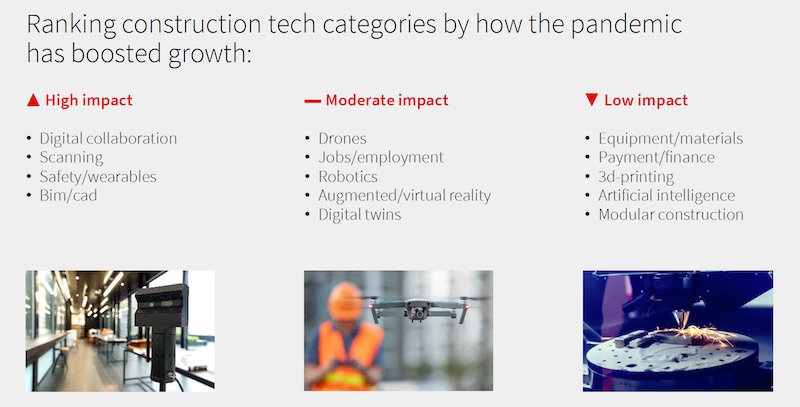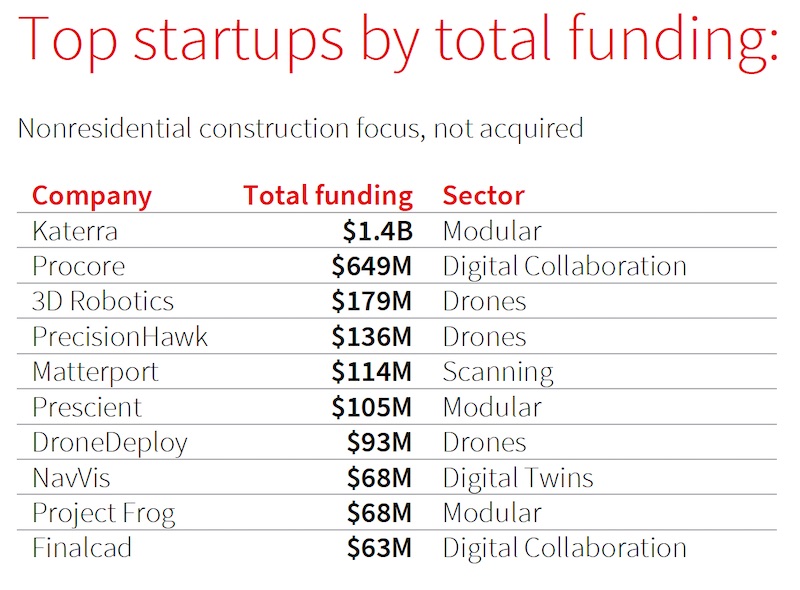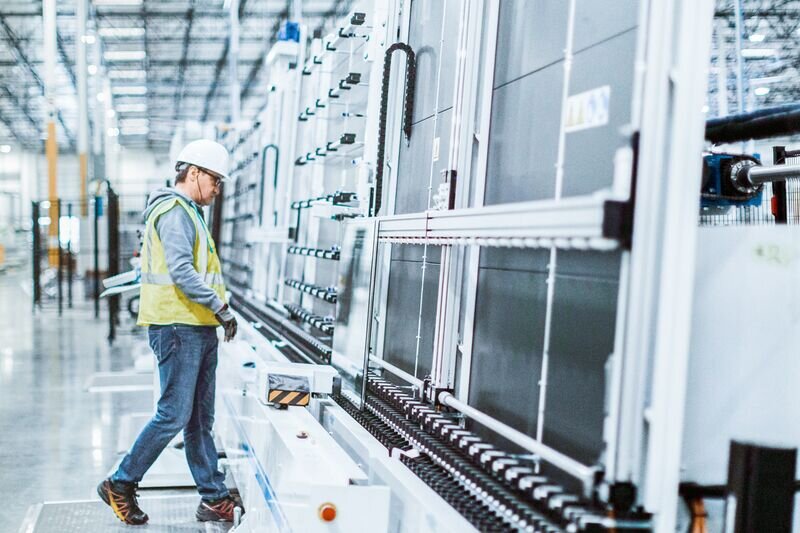The novel coronavirus pandemic has reshaped the construction industry, mostly positively in terms of operational efficiency and worker safety. It has also accelerated the growth—and funding for—construction technology, while creating a hierarchy for how broadly the industry has adopted these tools.
In its latest “State of Construction tech” report, released today, JLL aims to organize the wide range of technology options and measure how the pandemic has impacted their application by AEC firms and the clients on their projects.
Henry D’Esposito, JLL’s Construction Research Senior Analyst and the report’s author, asserts that, due to the pandemic, “three years of construction technology growth and adoption have been compressed into the past nine months.” Venture capital has continued to flow to startups, with funding levels about on par with the average for the past five years.
Construction tech kept jobsites open and projects running. It also allowed AEC firms whose employees were forced to work remotely to maintain their workflows. According to a recent U.S. Chamber of Commerce survey, 67% of the construction firms polled allowed employees to work from home. However, JLL notes that smaller firms were less likely to have systems in place.
Construction firms in general with fewer discretionary dollars were likelier to select proven tech solutions rather than take a risk on a less-mature startup.
WEARABLES IMPROVE WORKER SAFETY
ConTech enabled onsite execution in two ways, JLL observes: First, by creating opportunities to have fewer people on a jobsite. Second, by keeping anyone who is essential to being onsite as safe as possible.
“Technology solutions that have expanded this year include wearables and monitoring devices to ensure workers stay socially distanced and to allow contact tracing if any issues arise; and planning tools to enable optimal efficiency in staging and scheduling to ensure that teams stay separated,” says JLL.
Wearables were among the ConTech tools for which the impact of the pandemic on their usage was deemed “high” by JLL.

JLL has organized ConTech by its relative impact on construction, and whether the coronavirus affected that impact. Image: JLL
The report identifies the ConTech hierarchy into three groups:
•Foundational technologies that have become standard fare for AEC firms. These include BIM and CAD, digital twins, Artificial Intelligence (AI), and digital collaboration;
•Primary impact technologies that are gaining acceptance, such as scanning, drones, and modular construction; and
•Secondary impact technologies that are still in their early stages of adoption. Wearables falls into this category, as do 3D printing, robotics, AR/VR, and tools related to payments/finance, equipment/materials, and jobs/employment.
JLL believes that BIM and CAD, scanning, and digital collaboration each got a “pandemic boost,” whereas AI may have lost some steam. Scanning, for example, gained importance during the health crisis “as a way to replace additional eyes onsite, and as a substitute for in-person meetings and walkthroughs.” Prior to the pandemic, scanning was a more efficient and comprehensive way to collect data. But under regulations where a limited number of staff can be onsite at any time, “interior scanning has often become a necessity to ensure that all members of a project teams are on the same page, even if they cannot be onsite.”
ROBOTS AND 3D PRINTERS STILL HAVE A WAYS TO GO FOR INDUSTRY ACCEPTANCE

Venture capital funding for ConTech during 2020 was in line with levels over the past five years. Image: JLL
Drones, says JLL, got a moderate boost from the pandemic because “of their ability to do the work of multiple people, and to do so in a way that keeps people socially distanced.”
And while many AEC firms claim to be embracing modular construction for quicker project delivery, JLL finds that the impact of the pandemic hasn’t been much of a factor on leading more firms to this method. “On the positive side, modular manufacturing can be done in a controlled factory setting, with the ability for extensive preplanning to maintain social distancing without the unknowns of an active jobsite. On the negative side, modular construction remains an economically high-risk endeavor.”
The pandemic also has had mixed impact on other ConTech tools. Its effect on the adoption of 3D printing, for example, was low, says JLL, which predicts that the future of 3D printing is brighter for single-family home construction or certain military applications than for nonresidential construction.
JLL is a bit more sanguine about robotics, which got a moderate boost from the pandemic. “With the addition of AI, this sector is developing for more advanced tasks, including fully automated excavation or interior chalk lining.” Nevertheless, JLL expects robots to be used on a limited basis for pilot projects for at least the next few years.
Augmented and virtual reality are still in their early development stages, and both have the potential to become standard on construction projects. But, JLL cautions, “they will only work on projects with high adoption of other forms of tech that would be required for integration.”
Related Stories
Webinar | Oct 6, 2022
Register today! Live webinar: The future of 3D + 360° construction progress management
Learn about the value of digital site documentation and progress monitoring, how reality capture is used for site documentation, and the value of both 3D scans and 360 photos. This live webinar will take place Thursday, October 20 at 2 ET/ 1 CT.
AEC Tech | Sep 23, 2022
Register today! Live webinar: 10 KPIs your AE firm needs to track for maximum project profitability
Join us for an engaging, live webinar presented by Steven Burns, FAIA, Chief Creative Officer at BQE Software as he explores 10 project performance KPIs that, when tracked properly, will transform the way your business operates, and subsequently how profitable each project is.
AEC Tech | Sep 15, 2022
Register today! Live webinar: Minimize project expenses to stay on budget with 360° photo capture
Learn how reality capture technology like 360° photo capture allows your on-site team to document jobsites faster and more accurately than ever. This live webinar will take place September 20, 2022, at 2 ET / 1 CT.
AEC Tech | Aug 8, 2022
The technology balancing act
As our world reopens from COVID isolation, we are entering back into undefined territory – a form of hybrid existence.
Security and Life Safety | Jul 5, 2022
What AEC firms should look for in a cybersecurity partner
When looking for expert partners in cybersecurity, AEC firms will find quite a lot of companies claiming to be at the forefront of modern threats. Here are five key points to look for when choosing a cybersecurity firm.
Laboratories | Jun 29, 2022
The "collaboratory" brings digital innovation to the classroom
The Collaboratory—a mix of collaboration and laboratory—is a networking center being designed at the University of Denver’s College of Business.
Augmented Reality | Jun 22, 2022
Not just for POKÉMON GO anymore: how augmented reality is transforming architecture
By solving a long-standing communication problem, Augmented Reality (AR) is poised to make architecture quicker, nimbler, and more cost effective.
Healthcare Facilities | Jun 20, 2022
Is telehealth finally mainstream?
After more than a century of development, telehealth has become a standard alternative for many types of care.
Smart Buildings | Jun 1, 2022
Taking full advantage of smart building technology
Drew Deatherage of Crux Solutions discusses where owners and AEC firms could do better at optimizing smart technology in building design and operations.
BAS and Security | May 26, 2022
Can your intelligent building outsmart hackers?
ESD's security services studio leader Coleman Wolf offers tips, advice, and lessons for protecting real estate assets from cyberattacks.

















